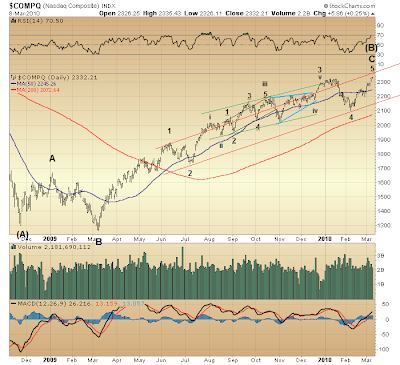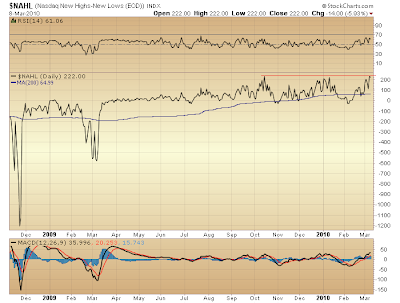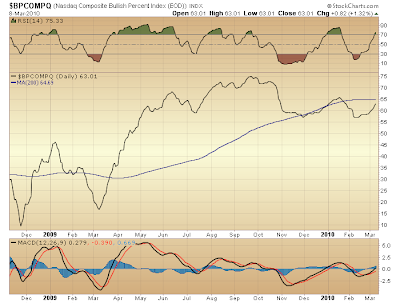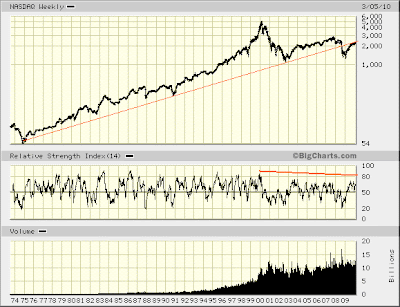The performance relationship between the NYSE and NASDAQ Composite indexes took one step closer today to resembling conditions at the top in 2007.
So, with $COMPQ reaching a new intra-day high today, post-March '09 bottom, only an alternate view toward its progress over that duration is required at the moment.

No problem.
RSI and MACD help substantiate the above view equally as effectively as both did $COMPQ's Elliott wave count prior to today.
Most critically is how both measures deteriorate during fourth wave versus second wave formation. You see this occurring during the unfolding of any five waves labeled above.
You also see above three Elliott wave channels, each containing the five component waves of wave iii of 3 of C, wave 3 of C, and wave C, respectively.
Wave iii is seen channeling to the peak of its first wave, wave 3 to the peak of its third wave, and wave C to the peak of its first wave. Another manifestation of "alternation" duly noted, then.

Similar technical configuration is seen via NASDAQ's new 52-week high-low differential, particularly deterioration during fourth wave versus second wave formation.
Now, should the fifth wave of $COMPQ's wave C forming off March '09 bottom bring NASDAQ's new 52-week high-low differential to widen, no problem. First, this is a C wave forming — a third wave, which typically is the most dynamic. Second, considering how much higher $COMPQ trades today versus one year ago, a new 52-week high-low differential of 222 is, to put it bluntly, pathetic. At this point, how much more is this measure likely to widen, anyway?
Absence of broad leadership helping propel NASDAQ higher still remains a red flag signaling distribution.

But more technical substantiation to the view suggesting the stock market is fixing to stumble, rather than launch another leg of some new bull market.
Thus, appreciating the likely thinness of that interest keeping equities levitated here without much resistance also is imagining just how quickly a trap door could be sprung.

Seeing the NASDAQ Composite Index still is banging on long-term resistance (formerly support), there's further reason to temper any concern that, $COMP's lift off early-February 2010 bottom, carrying the index to a new high, post-March '09, is anything other than the same old, same old to which we have been treated over the past nine months.
RSI: still fading ... now diverging, too.
Volume: still a tulip bubble (even while the flower loses its bloom).
Now, don't get me wrong. Because there is a ton of equity whose intermediate-term prospects are likely terminal, every effort will be made to offload as much of this exposure as possible, while illusions of financial system solvency still can be maintained.
So, just whether the Elliott Wave view toward indexes other than NASDAQ might likewise require a tweak remains a possibility. Still, under the covers, there is every indication supporting my view that, equity presently is being distributed to suckers.

* * * * *
© The Risk Averse Alert — Advocating a patient, disciplined approach to stock market investing. Overriding objective is limiting financial risk. Minimizing investment capital loss is a priority.
Analysis centers on the stock market's path of least resistance. Long-term, this drives a simple strategy for safely investing a 401(k) for maximum profit. Intermediate-term, investing with stock index tracking-ETFs (both their long and short varieties) is advanced. Short-term, stock index options occasionally offer extraordinary profit opportunities when the stock market is moving along its projected path.
Nothing is set in stone. Nor is the stock market's path of least resistance always known. More often than not, there are no stock index option positions recommended.
 There's an easy way to boost your investment discipline...
There's an easy way to boost your investment discipline...Get Real-Time Trade Notification!



















